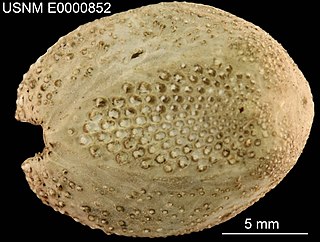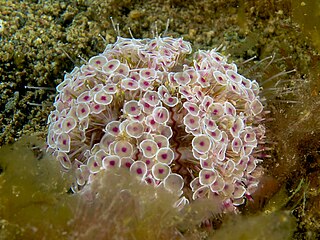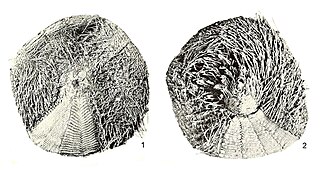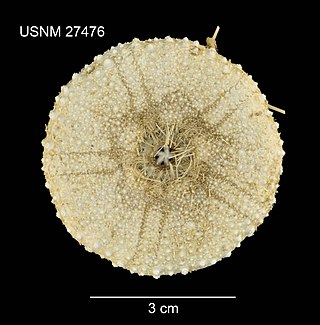
Aceste ovata is a species of sea urchin of the family Schizasteridae. Their armour is covered with spines. It came from the genus Aceste and lives in the sea. Aceste ovata was first scientifically described in 1907 by Alexander Emanuel Agassiz & Hubert Lyman Clark.
Amblypneustes grandis is a species of sea urchin of the family Temnopleuridae. Their armour is covered with spines. It is in the genus Amblypneustes and lives in the sea. Amblypneustes grandis was first scientifically described in 1912 by Hubert Lyman Clark.
Anametalia regularis is a species of sea urchin of the family Brissidae. Their armour is covered with spines. It is placed in the genus Anametalia and lives in the sea. Anametalia regularis was first scientifically described in 1925 by Hubert Clark.

Apatopygus occidentalis is a species of sea urchin of the family Apatopygidae. Their armour is covered with spines. It is placed in the genus Apatopygus and lives in the sea. Apatopygus occidentalis was first scientifically described in 1928 by Hubert Lyman Clark, American zoologist.
Aporocidaris fragilis is a species of sea urchin of the family Ctenocidaridae. It is well-armoured with spines. It is placed in the genus Aporocidaris and lives in the sea. Aporocidaris fragilis was first scientifically described in 1907 by Alexander Emanuel Agassiz & Hubert Lyman Clark.

Arachnoides tenuis is a species of sea urchin of the family Clypeasteridae. Their armour is covered with spines. It is placed in the genus Arachnoides and lives in the sea. Arachnoides tenuis was first scientifically described in 1938 by Hubert Lyman Clark.
Araeosoma eurypatum is a species of sea urchin of the family Echinothuriidae. Its armour is covered with spines. It is placed in the genus Araeosoma and lives in the sea. A. eurypatum was first scientifically described in 1909 by Alexander Agassiz and Hubert Clark.

Araeosoma leptaleum is a species of sea urchin of the family Echinothuriidae. Its armour is covered with spines. It is placed in the genus Araeosoma and lives in the sea. A. leptaleum was first scientifically described in 1909 by Alexander Emanuel Agassiz & Hubert Lyman Clark.
Araeosoma paucispinum is a species of sea urchin of the family Echinothuriidae. Its armour is covered with spines. It is placed in the genus Araeosoma and lives in the sea. A. paucispinum was first scientifically described in 1924 by Hubert Lyman Clark, an American zoologist.

Araeosoma thetidis is a species of sea urchin of the family Echinothuriidae that lives in deep sea off Australia and New Zealand. A. thetidis was first scientifically described in 1909 by Hubert Lyman Clark.

Toxopneustes is a genus of sea urchins from the tropical Indo-Pacific. It contains four species. They are known to possess medically significant venom to humans on their pedicellariae. They are sometimes collectively known as flower urchins, after the most widespread and most commonly encountered species in the genus, the flower urchin.

Asthenosoma intermedium is a species of sea urchin of the family Echinothuriidae. Their armour is covered with spines. It is placed in the genus Asthenosoma and lives in the sea. Asthenosoma intermedium was first scientifically described in 1938 by Hubert Lyman Clark.
Brisaster kerguelenensis is a species of sea urchins of the family Schizasteridae. Their armour is covered with spines. Brisaster kerguelenensis was first scientifically described in 1917 by Hubert Lyman Clark.
Caenopedina superba is a species of sea urchins of the family Pedinidae. Their armour is covered with spines. Caenopedina superba was first scientifically described in 1925 by Hubert Lyman Clark.

Chaetodiadema pallidum is a species of sea urchins of the Family Diadematidae. Their armour is covered with spines. Chaetodiadema pallidum was first scientifically described in 1907 by Alexander Emanuel Agassiz and Hubert Lyman Clark.
Chaetodiadema tuberculatum is a species of sea urchins of the Family Diadematidae. Their armour is covered with spines. Chaetodiadema tuberculatum was first scientifically described in 1909 by Hubert Lyman Clark.
Chorocidaris micca is a species of sea urchins of the Family Cidaridae. Their armour is covered with spines. Chorocidaris micca was first scientifically described in 1941 by Ikeda.
Clypeaster elongatus is a species of sea urchins of the family Clypeasteridae. Their armour is covered with spines. Clypeaster elongatus was first scientifically described in 1948 by Hubert Lyman Clark.

Toxopneustes maculatus is a rare species of sea urchin found in the Indo-West Pacific.

Chondrocidaris is a genus of sea urchins of the family Cidaridae described in 1863 by Alexander Agassiz. There are two living species and several fossil species dating as far back as the Miocene.











